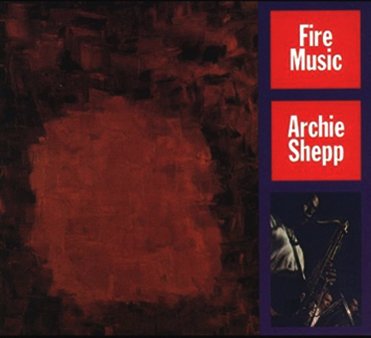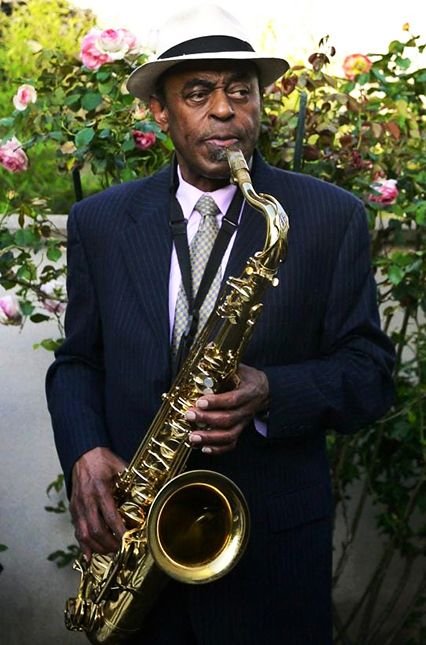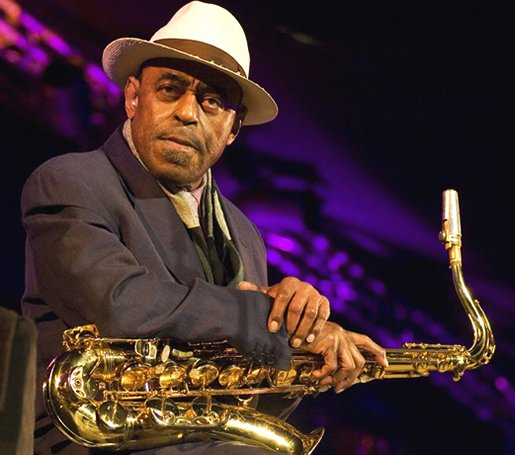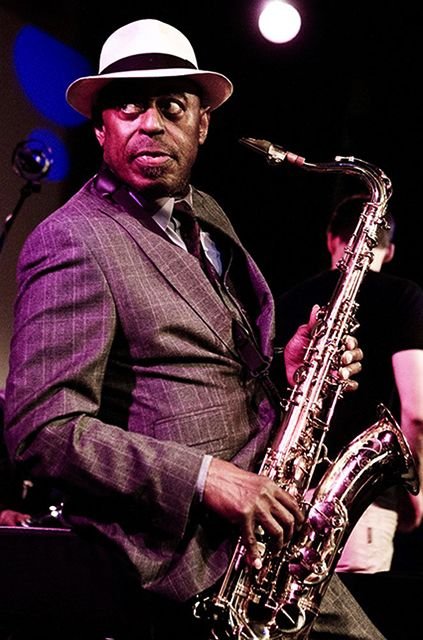Hambone
Marion Brown (saxo alto), Archie Shepp (saxo tenor), Ted Curson (trompeta), Joseph Orange (trombón), Reggie Johnson (contrabajo) y Joe Chamber (batería). Extraído del álbum Fire Music (1965) de Archie Shepp.
Archie Shepp es un saxofonista tenor de jazz, escritor, compositor y profesor norteamericano. En los años sesenta era un agitador radical dispuesto a hablar sobre la injusticia social, la ira y la rabia que sentía sin reservas. Sus primeras influencias fueron los saxofonistas tenores Ben Webster y John Coltrane. Su sonido tiene un tono áspero, un amplio vibrato, un swing intenso, fuertes gritos y efectos multifónicos, y sus solos son ardientes, duros e implacables, tocados con un gran entusiasmo. Nacido en la ciudad de Fort Lauderdale, al principio su instrumento era el saxofón alto y en 1960 tocó con orquestas de baile y un grupo de jazz latino en Nueva York, pero luego lo cambió por el saxofón tenor y se incorporó al cuarteto del pianista Cecil Taylor, precursor del free jazz, durante dos años. En 1962 grabó su primer álbum Archie Shepp - Bill Dixon Quartet con Savoy Records. También formó el New York Contemporary Five con John Tchicai al saxofón alto, Don Cherry a la trompeta, Don Moore al contrabajo y J.C. Moses a la batería, con el que grabó cinco álbums e hicieron una gira por Europa, pero el grupo se disolvió en 1964. Después firmó un contrato con el sello Impulse!, con el que grabó 17 álbums, y en 1965 participó en el álbum esencial Ascension de John Coltrane.
Archie Shepp is an American jazz tenor saxophonist, writer, composer and teacher. In the 1960s he was a radical agitator willing to talk about the social injustice and the anger and rage he felt outright. His first influences were tenor saxofonists Ben Webster and John Coltrane. His sound has a rough tone, a broad vibrato, an intense swing, loud screams and multifonic effects, and his solos are fiery, hard and implacable, played with great enthusiasm. Born in the city of Fort Lauderdale, at first his instrument was the alto saxophone and in 1960 he played with dance orchestras and a Latin jazz group in New York, but then he switched to the tenor saxophone and joined pianist Cecil Taylor’s quartet, precursor of free jazz, for two years. In 1962 he recorded his first album Archie Shepp - Bill Dixon Quartet with Savoy Records. He also formed the New York Contemporary Five with John Tchicai on alto saxophone, Don Cherry on trumpet, Don Moore on double bass and J.C. Moses on drums, with which he recorded five albums and toured Europe, but the group dissolved in 1964. He then signed a contract with the Impulse! label, with which he recorded 17 albums, and in 1965 he participated in John Coltrane’s essencial album Ascension.

En 1965 Shepp publicó Fire Music, donde se puede apreciar el comienzo de su despertar político y cuyo título procede de una tradición musical ceremonial africana. A mediados de la década de los sesenta formó grupos con los trombonistas Roswell Rudd y Grachan Moncur III, el vibrafonista Bobby Hutcherson y el batería Beaver Harris. En 1967 grabó The Magic of Ju-Ju, que incluye un pequeño conjunto de percusión africano. En aquella época, muchos músicos de jazz afroamericanos estaban interesados en las tradiciones musicales y culturales africanas, y Shepp estaba al frente de este movimiento junto con el saxofonista tenor Pharoah Sanders. Al mismo tiempo escribía ensayos que vinculaban el free jazz con la militancia negra, leía sus propias poesías y citas de James Baldwin y Malcom X en sus grabaciones, y componía obras de teatro.
In 1965 Shepp published Fire Music, where you can see the beginning of his political awakening and whose title comes from an African ceremonial musical tradition. In the mid-1960s he formed groups with trombonists Roswell Rudd and Grachan Moncur III, vibraphonist Bobby Hutcherson and drummer Beaver Harris. In 1967 he recorded The Magic of Ju-Ju, which includes a small African percussion ensemble. At that time, many African American jazz musicians were attracted to African musical and cultural traditions, and Shepp was at the forefront of this movement along with tenor saxofonist Pharoah Sanders. At the same time he wrote essays linking free jazz with black militancy, read his own poetry and quotes from James Baldwin and Malcom X in his recordings, and composed theater plays.

Pero en los años setenta desapareció el fuego y la furia de sus principios y empezó a interpretar una especie de rhythm and blues basado en el swing, y en los años ochenta blues, baladas, espirituales y bebop. De 1968 a 1972 impartió clases en el State University of New York en Buffalo y de 1972 al 2002 en la University of Massachusetts en Amherst. Durante los años ochenta también hizo numerosas giras por Europa y grabó con los pianistas Horace Parlan y Jasper van’t Hof, y el contrabajista Niels-Henning Ørsted Pedersen. En 1981 apareció en el documental canadiense Imagine the Sound sobre el free jazz junto a otras figuras pertenecientes a este estilo. En 1984 también apareció en el documental francés sobre Sun Ra Mystery, Mr. Ra. Sheep ha continuado haciendo giras y grabando hasta la actualidad.
But in the 1970s the fire and fury of his principles disappeared and he began to perform a kind of rhythm and blues based on swing, and in the 1980s, blues, ballads, spirituals and bebop. From 1968 to 1972 he taught at the State University of New York in Buffalo and from 1972 to 2002 at the University of Massachusetts in Amherst. During the 1980s he also made numerous tours for Europe and recorded with pianists Horace Parlan and Jasper van’t Hof, and double bassist Niels-Henning Ørsted Pedersen. In 1981 he appeared in the Canadian documentary Imagine the Sound about free jazz together with other figures belonging to this style. In 1984 he also appeared in the French documentary on Sun Ra Mystery, Mr. Ra. Sheep continues touring and recording to the present day.

Johnson y Chambers empiezan a tocar, y pronto se incorpora el resto del grupo para exponer un tema muy contundente por la amplia sección de viento y con cambios instrumentales constantes y bloques de acordes oscuros y disonantes. El primero en hacer su solo es Curson mientras el resto de la sección rítmica le hace acompaña por detrás con una frase repetitiva. Curson intercambia pasajes equilibrados con otros más impetuosos y atrevidos, pero al final se queda solo con la sección rítmica y se tranquiliza. De repente el grupo interpreta un arreglo para dar paso a Brown con un discurso sugerente y bluesy en el que introduce frases más intensas. Después el grupo toca otro arreglo y entra Orange tocando de forma pausada, pero bien articulada mientras el resto de la sección rítmica le acompañan de nuevo por detrás de forma reiterativa hasta que todos se tranquilizan. De inmediato vuelve el acompañamiento repetitivo y entra Shepp con un sonido rugoso tocando de forma libre y apasionada, llegando en ocasiones a ser arrollador, y al final de nuevo el grupo se tranquiliza. Para terminar, el grupo reexpone una pequeña sección del tema.
Johnson and Chambers begin to play, and soon the rest of the group joins in to expose a very robust theme because of the wide wind section with constant instrumental changes and blocks of dark and dissonant chords. The first to make his solo is Curson while the rest of the rhythm section supports him in the background with a repetitive phrase. Curson exchanges balanced passages with more impetuous and daring ones, but in the end he is left alone with the rhythm section and calms down. Suddenly the group delivers an arrangement to give way to Brown with a suggestive and bluesy discourse in which he introduces more intense phrases. Then the group plays a new arrangement and Orange enters playing slowly, but well articulatedly while the rest of the rhythm section supports him in the background below until everyone settles down. Right away the repetitive support comes back and Shepp reappears with a harsh sound playing in a free and passionate way, sometimes becoming overwhelming and at the end the group calms down again. To finish, the group re-exposes a small section of the theme.

Translated with the help of DeepL

Los Olvidados
Marion Brown (saxo alto), Archie Shepp (saxo tenor), Ted Curson (trompeta), Joseph Orange (trombón), Reggie Johnson (contrabajo) y Joe Chamber (batería). Extraído del álbum Fire Music (1965) de Archie Shepp.
Este tema es muy largo y tiene varias partes. Al principio es simpático e inocente, pero luego aumenta su intensidad. Hay un parón y a continuación se vuelve imprevisible y abstracto. Luego cambia a un ritmo más rápido, pero regresa a su naturaleza experimental anterior. Después Chambers hace una intervención y luego provee un ritmo regular en el que los músicos tocan de forma más fluida, pero dura poco porque rápidamente se producen cambios repentinos tanto en el ritmo como en la melodía. Finalmente, Curson comienza tocando frases entrecortadas, el resto de la sección rítmica hace un riff y Curson sigue, pero ahora su línea melódica es más continuada. Vuelve a sonar el riff, al cabo de un rato el grupo toca un pequeño arreglo y Curson coge la sordina, desciende la velocidad y termina su solo. Se hace otro silencio y el grupo vuelve con un ritmo lento tocando de forma libre. A continuación entra Brown interpretando un pasaje corto y el grupo retorna, pero esta vez con más fuerza y rapidez para dar paso a Shepp con su discurso free jazz característico mientras vuelve a sonar el riff varias veces a lo largo de su solo. Shepp exprime el saxofón de manera desgarradora hasta que vuelve el grupo brevemente y termina de forma abrupta.
This theme is very long and has several parts. At first it’s nice and innocent, but then it increases its intensity. There is a break and then it becomes unpredictable and abstract. Then it changes at a faster rate, but returns to its previous experimental nature. After that Chambers intervenes and later provides a regular rhythm in which the musicians play more fluently, but it doesn't last long because sudden changes in both rhythm and melody quickly occurs. At last, Curson starts playing broken phrases, the rest of the rhythm section makes a riff and Curson follows, but now his melodic line is more continuous. The riff sounds again, after a while the group plays a small arrangement and Curson takes the mute, lowers the speed and ends his solo. There is another silence and the group comes back at a slow rhythm playing freely. Next Brown enters interpreting a short passage and the group returns, but this time with more force and speed to give way to Shepp with his trademark free jazz improvisation while the riff sounds again several times throughout his solo. Shepp squeezes the saxophone in a heartbreaking manner until the group briefly comes back and ends abruptly.

℗ Impulse! Records


¡Enhorabuena!
✅ Has hecho un buen trabajo, por lo cual tu publicación ha sido valorada y ha recibido el apoyo de parte de CHESS BROTHERS ♔ 💪
♟ Te invitamos a usar nuestra etiqueta #chessbrothers y a que aprendas más sobre nosotros.
♟♟ También puedes contactarnos en nuestro servidor de Discord y promocionar allí tus publicaciones.
♟♟♟ Considera unirte a nuestro trail de curación para que trabajemos en equipo y recibas recompensas automáticamente.
♞♟ Echa un vistazo a nuestra cuenta @chessbrotherspro para que te informes sobre el proceso de curación llevado a diario por nuestro equipo.
🥇 Si quieres obtener ganancias con tu delegacion de HP y apoyar a nuestro proyecto, te invitamos a unirte al plan Master Investor. Aquí puedes aprender cómo hacerlo.
Cordialmente
El equipo de CHESS BROTHERS
¡Felicitaciones!
1. Invierte en el PROYECTO ENTROPÍA y recibe ganancias semanalmente. Entra aquí para más información.
3. Suscríbete a nuestra COMUNIDAD, apoya al trail de @Entropia y así podrás ganar recompensas de curación de forma automática. Entra aquí para más información sobre nuestro trail.
4. Creación de cuentas nuevas de Hive aquí.
5. Visita nuestro canal de Youtube.
Atentamente
El equipo de curación del PROYECTO ENTROPÍA
Me gusta a mucho el Jazz auque desconocía está información, me parece bastante interesante ya voy a descargar su álbum